Ethiopia has one of the fastest growing economies in Africa. Long a cypher for everything that was wrong with continent, the country is now racing ahead, developing its industry and agriculture at breakneck speed. The potential for growth is huge, but many fragilities remain. Water resources management is a case in point. Parts of the country suffer from regular water shortages. Other areas have plentiful rainfall, but it is highly seasonal. 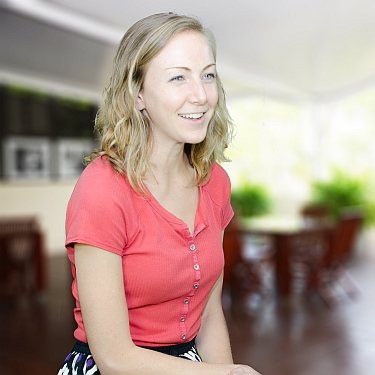 Water will need to be carefully husbanded if the current rate of development is to be sustainable.
Water will need to be carefully husbanded if the current rate of development is to be sustainable.
Rachel Cramer, a Princeton in Asia fellow working in IWMI’s communication department, visited the country earlier this year. She presents here four stories reflecting on IWMI’s science, and how local farmers are adapting to unique water resource challenges as the country undergoes the most rapid growth in its history.
Will high-tech water management make rose production in Ethiopia more sustainable?
Commercial greenhouses are popping up around Lake Ziway, a few hours south of the Ethiopian capital Addis Ababa. As the largest source of freshwater in the country’s Central Rift Valley, smallholder farmers, fisheries and wildlife have long-depended on it. But as demand for water continues to grow, sustainable use will be paramount to support livelihoods and the environment.
“Around Lake Ziway, we can find examples of the commercial farms using high-tech approaches to sustainable water management,” said Simon Langan, IWMI Researcher of Agricultural Water Management and Head of Office in, Addis Ababa, Ethiopia. “IWMI’s work with the LIVES Project focuses on low-tech solutions geared toward smallholder farmers. But both approaches will be important to support equitable and efficient use of this precious resource.”
One company, AQ Roses, has implemented several measures to make its business more sustainable. As the recipient of eight environmental certificates, it demonstrates one approach to large-scale, high-tech water management.
A new irrigation tool is popping up in Ethiopia

It’s an early morning near the town of Meki, a few hours south of Addis Ababa by car. Farmer Tesfaye Beljige walks through his field of cabbages and stops to show us two black tubes rising from the soil. They seem out of place among the leafy greens, but these ‘wetting front detectors’ could help farmers save water while also increasing yields.
Knowing when and how much to irrigate can be tricky. Too much water can be just as bad as too little with over-irrigation as one of the leading causes of land degradation. The detectors help farmers more accurately use just the right amount. Tesfaye received a pair, and training on how to use them from the International Water Management Institute (IWMI) through the multi-partner LIVES Project.
Each detector consists of a tube, funnel, filter and float. The funnel is buried within the root zone of the plant. As water soaks into the soil, it collects in the funnel and passes through the filter. A float rises through the tube, causing an ‘indicator flag’ to pop up. When the farmer sees the flag, he or she knows that the soil has enough water.
By using a pair of detectors – one buried halfway down the root zone of the crop and another at the end of the root zone – the farmer knows even more precisely when the plant has received enough moisture. The detectors operate mechanically and do not require batteries nor electricity. The soil water collected within the reservoir of the funnel can also be used to test nutrient and salt levels, indicating nutrient leaching and potential salinization of the irrigated fields.
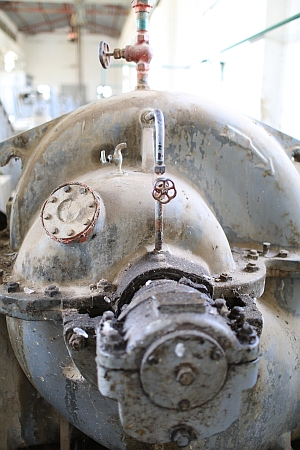
By encouraging more efficient water use, the detectors are helping farmers like Tesfaye cope with water challenges. Over 750 households rely on Lake Ziway for irrigation. While the water level remains relatively the same, the volume is actually decreasing: demand for water from smallholder farmers, commercial growers and nearby communities has grown while soil erosion from the highlands increases sedimentation in the lake.
Additionally, the large pump which brings water to Tesfaye and his neighbors is falling into disrepair. The infrastructure was provided by North Korea over 20 years ago, and finding the right parts, let alone the maintenance manuals, is proving to be incredibly difficult. Groundwater is available to some farmers, but high salt levels in the water are problematic for long-term irrigation. More efficient use of what water they have is more important than ever.
“When you save water at the farm level by using the wetting front detectors, you contribute toward sustainable watershed management as a whole,” said Petra Schmitter of IWMI. “One example of unstainable watershed management is the Aral Sea that dried up due to over-irrigation and reduction of groundwater replenishment. It’s a similar danger you can have in watersheds where irrigation is new and water is used in a non-sustainable way. After a few years, your rivers will dry up in the dry season.”
Whetting the appetite
As part of the wetting front detector trials, farmers maintain irrigation records, including the date and time of irrigation and how long it takes to irrigate the section. This information will help researchers and extension workers better understand how the detectors can be used most effectively.
While Tesfaye says it is too early for him to fully understand the benefits of the detectors, he has noticed that his cabbages are larger and more uniform in the trial plot.
“I used to water my cabbages every three days,” he said. “But with these tools I only irrigate every five to six days. I like using them.”
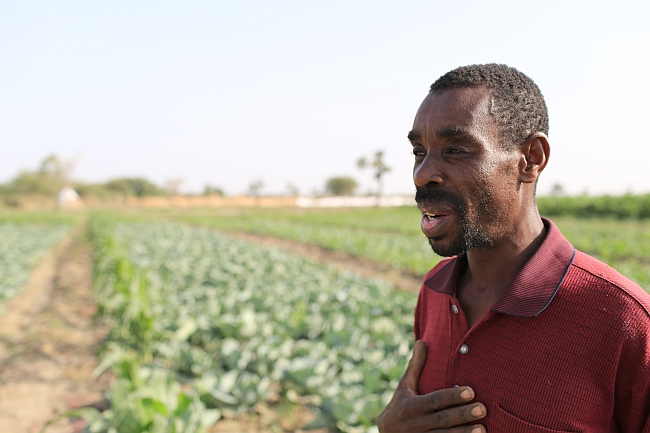
Schmitter believes the new tools could provide a cheap and effective way to achieve more efficient water use and boost incomes for farmers like Tesfaye.
The Ethiopian government has recently highlighted the importance of small-scale irrigation in its ambitious plan to lift millions of people out of poverty. If the trials prove successful, the wetting front detectors could start popping up more often.
[hr top=”yes”/]
Petra Schmitter is an Agricultural Water Management Researcher, based out of the IWMI-East Africa and Nile Regional Office in Addis Ababa, Ethiopia.
The Livestock and Irrigation Value chains for Ethiopian Smallholders (LIVES) Project contributes to enhanced income and gender equitable wealth creation for smallholders and other value chain actors in Ethiopia through increased and sustained market off-take of high value livestock and irrigated crop commodities.
To learn more: http://lives-ethiopia.org/about/
This work has been undertaken as part of the CGIAR Research Program on Water, Land and Ecosystems (WLE).
Urban farming brings fresh food to Ethiopia’s city dwellers
Standing atop Entoto Mountain, Ethiopia’s capital Addis Ababa spreads out like a patchwork of high-rises, slums and construction sites. It is one of the fastest growing cities in Africa with a population that has more than tripled since 1970. While the majority of the country’s population is still rural and largely dependent on smallholder farming, more Ethiopians are leaving the farm for job opportunities in the big city.
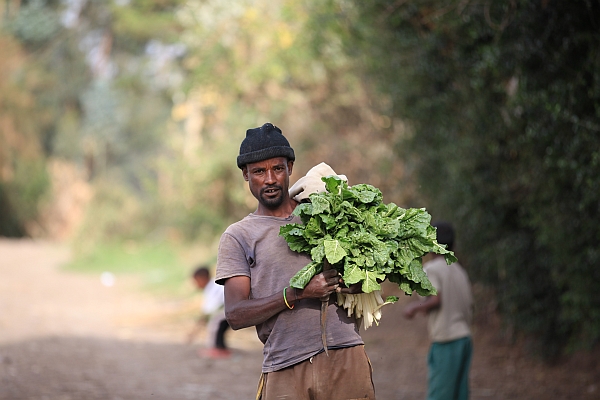
But urbanites still need fresh food, and city farming has increasingly become a key source of fruits and vegetables to supplement starchy staples. It’s a trend that’s gaining ground across the globe; a study released by the International Water Management Institute (IWMI) earlier this year found that 456 million hectares (about 1.1 billion acres) are currently being used to produce food in and around the world’s cities, an area roughly the size of the European Union. In Ethiopia and other countries in sub-Saharan Africa, for example, urban farmers provide 90% of the leafy greens to city dwellers. Growing food in cities can also generate income for the poor, put marginal land to use, increase biodiversity and help with flood control.

Central to the success of these urban farms is the availability and sustainable use of water, especially as the competition for freshwater for industry and domestic needs continues to rise. Cooperatives such as the Urban Farming Association in Addis Ababa can act as the mediating link between individual city farmers and the government – an integral part in ensuring water needs are met.
The association manages seven dams, which are supported with subsidies. Non-members of the association can also use the dams, but they are required to make a financial contribution when the dams are in need of repairs. Farmers receive water for irrigation through a pipeline connected to a nearby dam.
To belong to the association, farmers must own their land and attend monthly meetings. The association supports farmers through agricultural training and helps with marketing, loans and accessing equipment, seedlings and fertilizer.
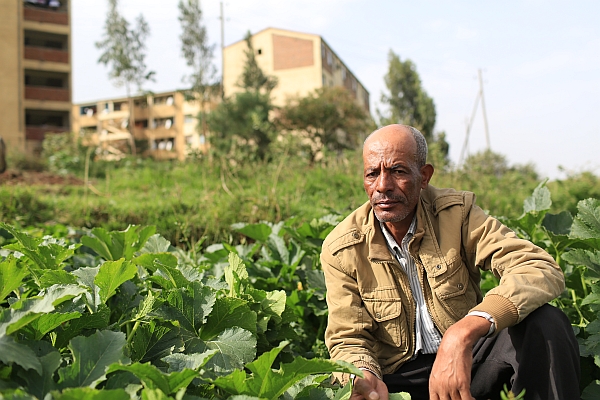
“Unity is power,” says Fuje Sebani, urban farmer and member of the cooperative. “The association helps us get water for irrigation and accomplish our goals.” Fuje is one out of 300-plus farmers who belong to the association, more than half of whom are women.
Near a newly constructed apartment building, Fuje’s brother Fekadu shows us his plot of land where he is currently growing cucumbers. He consumes a small amount of produce in his home, but the majority is sold at a local market. With the income he earns, he is able to support his family and pay for his children’s education.
Irrigation is an important contributor to his success as an urban farmer. Apart from the rainy season (June-August), Fekadu irrigates his cabbages every five days and his zucchini plants every 12 days.
The need for irrigation will grow alongside the upward trend of urban farming. IWMI researchers and partners are looking at technical and economically viable options to treat wastewater and use it to grow safe and nutritious food. The book Irrigated urban vegetable farming in Ghana: Characteristics, benefits and risk mitigation covers ten years of research, providing an in-depth look at the issue and highlighting opportunities for safe reuse of this untapped resource.
To learn more, visit: http://www.iwmi.cgiar.org/2014/11/farming-on-the-doorstep/
[hr top=”yes”/]
Read the new IWMI book:
Drechsel, Pay, Qadir, Manzoor, Wichelns, Dennis (Eds.) 2015. Wastewater: Economic Asset in an Urbanizing World. Springer. 282 p. 45 illus., 10 illus. in color.
Knowing the life-story of water is key to sustainable irrigation in Ethiopia
As machines hum and liquids drip into a row of beakers, isotope hydrologist Seifu Kebede tells us, “Each body of water has its own unique identity. Like a fingerprint.”

IWMI researchers have recently started working with Seifu, the Head of Ethiopia’s National Isotope Hydrology Lab, to better understand how water moves through landscapes. Specifically, the researchers want to quantify how much groundwater is supplied by floodwaters and wetlands near Lake Tana, the largest water body in Ethiopia. By understanding where the groundwater comes from and how old it is, the researchers will be better equipped to make small-scale irrigation more sustainable. Using isotopes is one of the best ways to do this.
But what exactly are they?
Isotopes are naturally occurring variations of an element. For example, water can contain different kinds of oxygen, such as the oxygen-16 isotope, with eight neutrons and eight protons. But it can also contain the oxygen-18 isotope, which has 10 neutrons and eight protons. With two more neutrons, the oxygen-18 isotope is slightly heavier than the oxygen-16 isotope.
This means that if a lake is experiencing a significant amount of evaporation, the lighter oxygen-16 isotopes will evaporate more quickly, leaving behind a higher percentage of the heavier oxygen-18 isotope. Researchers can compare the ratio of these isotopes to understand changes to the lake over time. The oxygen-16 and oxygen-18 isotopes are examples of ‘stable isotopes’ because they do not break down or ‘decay’.
Similarly, researchers can use tritium – a radioactive isotope of hydrogen – to understand the age of groundwater. It occurs naturally in the atmosphere and collects in rainfall. Once it enters the ground, it begins to decompose. If a wetland is frequently supplying groundwater, the tritium percentage would be very high, but if the main source is soil moisture from distant highlands, it would have had more time to decompose, resulting in a lower percentage. It means that scientists can take a sample of water and get an idea of where it has come from.
The National Isotope Hydrology Lab, hosted by Addis Ababa University, is the only facility in Ethiopia currently equipped to analyze tritium and stable isotopes. It also has a machine that can trap and analyze water vapor, helping researchers understand atmospheric patterns and study isotopes even without a water sample. In addition, the lab can test water samples for heavy metals such as cadmium, lead and zinc to monitor pollution levels. Later this year, the lab will be acquiring a carbon isotope machine to test sediments.
The lab was established with support from the International Atomic Energy Agency (IAEA), and while the partnership with IWMI is new, it has served several Ethiopian institutions for the last ten years.
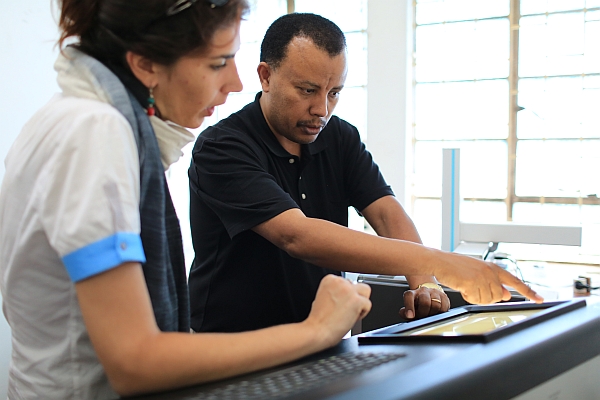
As we pass through the lab, Seifu stops to show IWMI Researcher Petra Schmitter and I some of the samples undergoing the tritium analysis. Once the samples are brought to the lab, they are distilled, which separates the elements to be tested. They are then electrolyzed under cold temperatures to break the hydrogen and oxygen bonds, and treated with a jelly to collect the tritium. A machine counts the number of alpha rays, which lets the researchers know the amount of tritium present in the sample. Around seven days are needed to run the analysis.
Petra is part of the IWMI team working on the groundwater project near Lake Tana. With the help of two PhD students, they have collected their first samples and are awaiting the test results.
Petra tells us, “Isotopes are a very exciting new area of research with practical applications. Using the information they provide, we can help guide farmers in how much water can be extracted in a sustainable way for irrigation. For example, if the rate of replenishing groundwater is very slow, farmers need to be more conservative to ensure that the water will be available for future use. To use water efficiently, we need a baseline of information first.”
The researchers can also use isotopes to study erosion and develop solutions. For example, if a high concentration of a hillside’s isotope fingerprint is found in a wetland, the researchers have evidence that erosion is taking place. They can then measure whether interventions, such as terraces, are actually working by comparing the before and after levels of isotopes.
[hr top=”yes”/]
Seifu Kebede, is the Head of the National Isotope Hydrology Lab and the School of Earth Science, Addis Ababa University, Ethiopia.
Petra Schmitter is a Researcher in Agricultural Water Management at the IWMI-East Africa/Nile Basin Office in Addis Ababa, Ethiopia.

